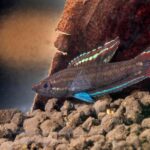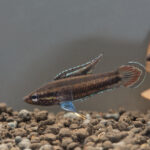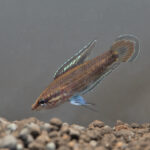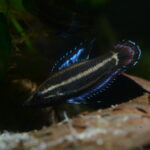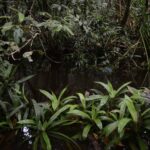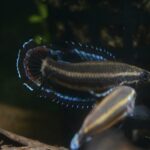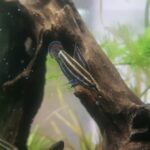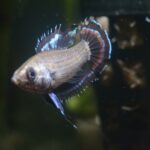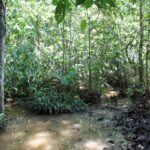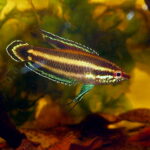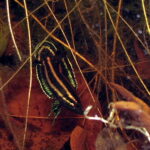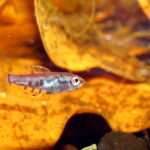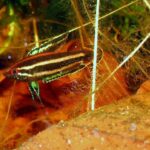
Kottelat & Ng 2005
First description: Diagnoses of six new species of Parosphromenus (Teleostei: Osphronemidae) from Malay Peninsula and Borneo, with notes on other species. The Raffles Bulletin of Zoology 2005 Supplement No. 13: 101-113.
Characteristics:licorice gourami from the bintan-harvey family. total length max. 3.5 cm. Fin formula: Dorsal: XI-XII, 5-7, total 16-19, anal fin: XIII-XIV, 6-8, total 19-21. Rounded caudal fin. The male always has a pointed dorsal fin, partly very long, almost like a pennant. It always shows a fine white egde of the coloured unpaired fins, a feature that is not to be found in the females. The male always shows, besides the striking turquoise bands, species-typical red markings in the dorsal fin (body-sided band) and caudal fin (often extended red central area), band-like also in the rear area of the anal fin, extended forward just before the pelvic fins in some individuals. This species has a certain variability, not only specific to the locality, but also to the strain or even the clutch. The ventral fins are blue to black-green; the filaments are long and black.
Similar species: superficially regarded, the males can be confused with other species, which have red components in the unpaired fins. The risk of confusion in females is generally high. Males can easily be confused with P. Alfredi. The only clear difference is in the ventral fins, which are light blue to white for alfredi, while rubrimontis males have blue, black-green or black. These very dark ventral filaments are also an important feature for the differenciation with P. opallius.
Occurrence / Distribution: West-Malaysia, province Perak. The terra typica near Bukit Merah (meaning “red mountain” just like the species name), originally a very impressive area, and rich in species, is almost completely destroyed today.. However the species still exists in remaining swamp areas in the surrounding (as of 2011).
Threat: very high, the terra typica has already been destroyed by draining and conversion into agricultural land (oil palm) during the time of the first description. The other small scale habitats in the surrounding, where the species still occurs, are highly endangered by similar developments. P. Rubrimontis is one of the most beautiful and most endangered licorice gouramis.
Discovery/First import: date of discovery unclear, because at first – like in other cases – in the belief only one widespread parosphromenus “deissneri” exists, the species was confused with this one. R. Ottinger brought the species to Europe from Bukit Merah in beginning of 1984. Since then several private imports took place, mainly by enthusiasts (e.g. Z. Zakaria, H. Linke), in the end only from relict localities in the further surrounding of Bukit Merah.
Trade: before the destruction of the original locality, the species appeared a few times in the international trade under false names (trade names or “deissneri”). Since then only few commercial imports of rubrimontis-forms took place. These strains, partly with variable colouration, have been kept and bred seperately as a precaution.
Care / Breeding: like other licorice gouramis. Linke found low pH values (between 3.5 and 4.5) and an extremely low conductivity (only up to 20 micro Siemens/cm) in the original habitat, a typical black water creek, which was very dark coloured by humic substances. These values should be pursued in the tank too. Very important is, besides a generally low salt content), the absence of germs. P. rubrimontis belongs to the more demanding species, regarding water quality and hygiene, if they should be kept and bred successfully over a longer time. Under these conditions, this is well possible. Small to medium sized clutches (average 20-40 eggs).
Behaviour / Particularities:Head-down courtship. Males in horizontal position showing dark coloured lower body part during aggressive confrontation with other males. Females become very pale, almost yellow during courtship.
Literature:
Weblinks:


